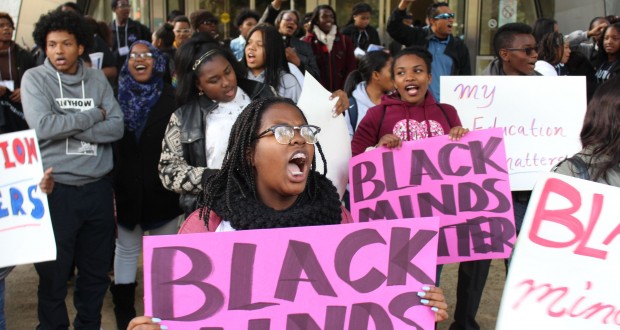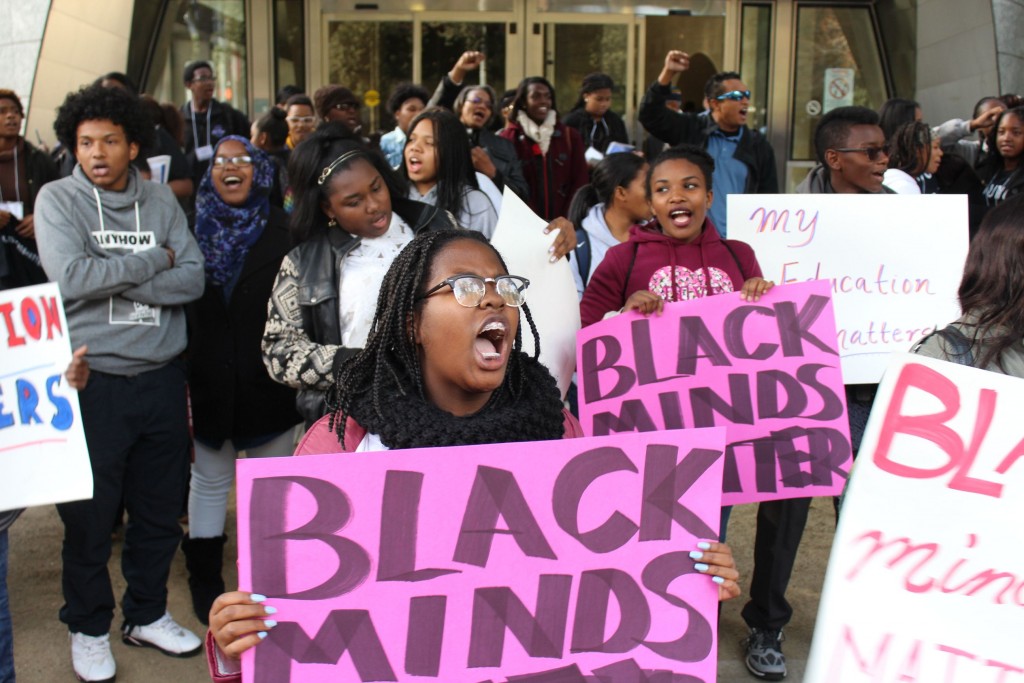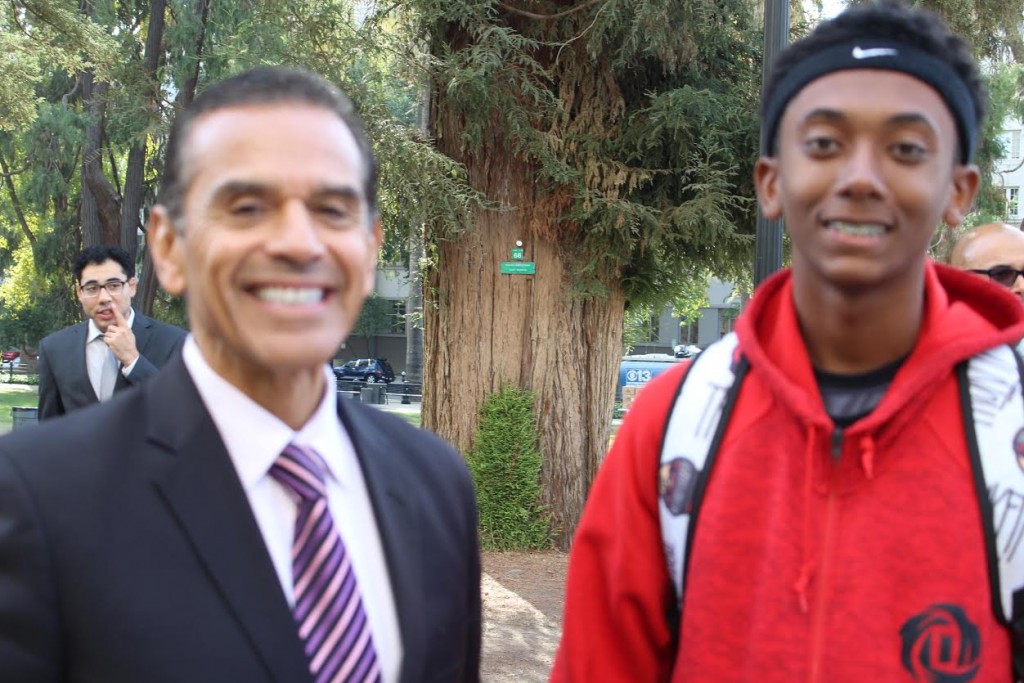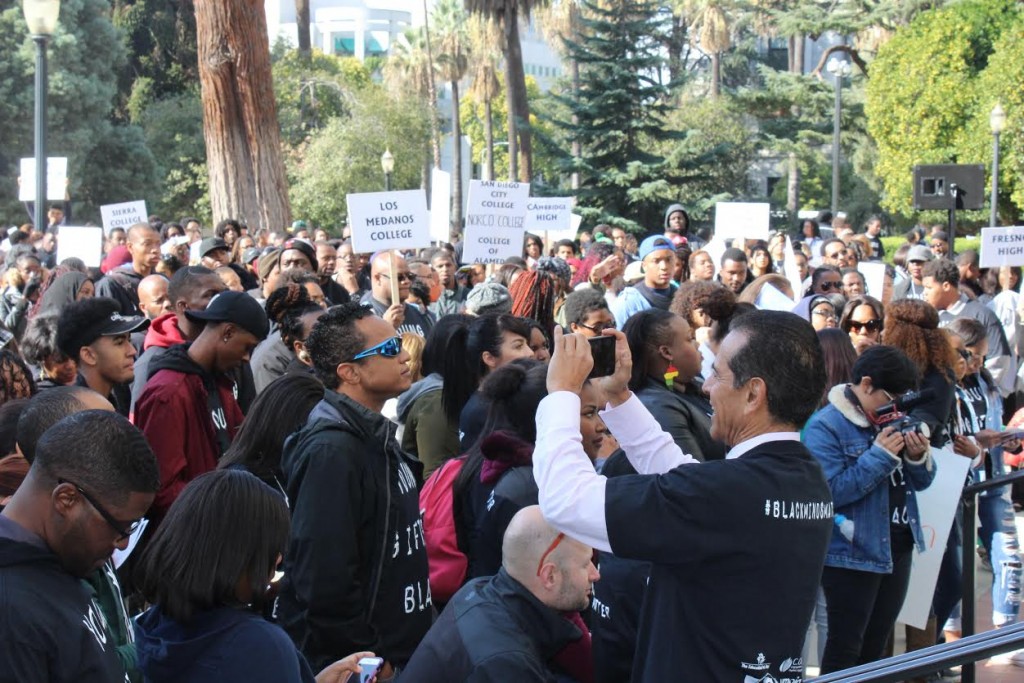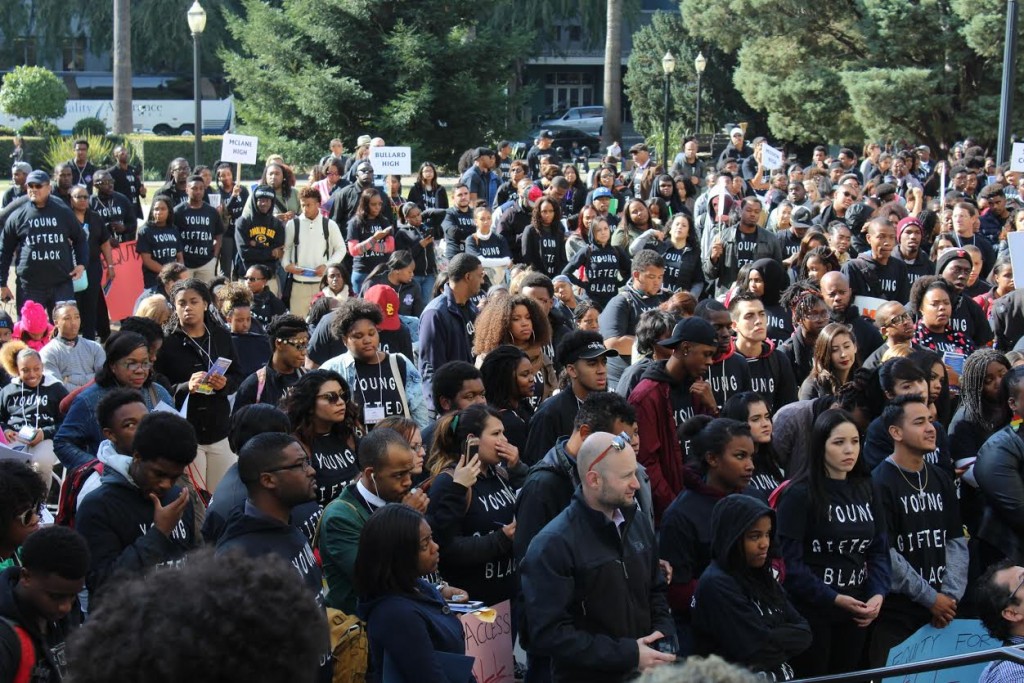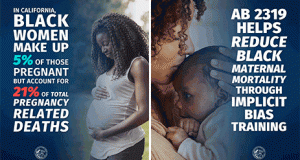By Angela M. Coggs
On November 4, 2015, 50 African-American students and educator chaperones from the Inland Empire boarded a charter bus at 11:00pm that was headed to Sacramento to rally for equal access to education in front the Department of Education and the state capital. The group, invited by Congregations Organized for Prophetic Engagement (C.O.P.E.), consisted of 9th -12th grade students from the following high schools: Cajon, Carter, Grand Terrace, Pacific, San Bernardino, and Summit. The trip was sponsored by The California Alliance of African- American of Educators (CAAAE), The California Endowment, The Education Trust-West, and UMOJA Community.
C.O.P.E. got involved in the Black Minds Matter rally because the Education Trust-West report features the work of the Task Force for African American Achievement, convened in the San Bernardino City Unified School District, as a promising practice for addressing
persistent poor academic outcomes for African American students. “We wanted students from our district to participate in the rally because of the important strides SBCUSD is making for African American students and to address their needs, “stated Felicia Jones, C.O.P.E. Associate Director.
The Education Trust-West recently released the Black Minds Matter white paper. The paper is a reality check for secondary and postsecondary education. At the subsequent Student Rally the goal was Black Minds Matter to serve as a rallying point for engagement and, discussion, and action. The rally was held at the state capital on Thursday November 5th at 10 am. The event was called Black Minds Matter – A Day of Student Activism.
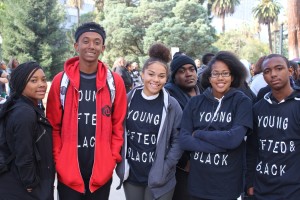
Cajon High School Students: Ashley Rodgers (10th), Yonathan Habtemariam(9th), Brianna Robertson(10th), Lyndon Nicholls(12th), Cherq’uora Hunn (10th), and Terriq Singer(11th)
The California Alliance of African- American of Educators (CAAAE) sent over 300 students and advocates to Sacramento to convene with over 200 Community college students attending the UMOJA conference and where they joined another 100 California State University and University of California systems students on the steps of the Capital Building to make a historic statement: “Black Minds Matter.” The mission of the California Alliance of African American Educators (CAAAE) is to provide programs and services to students, families, and teachers in order to create culturally conscious African American students who are life-long learners and critical thinkers. The summit featured highly-interactive workshops, dynamic student speakers, motivational words from inspired educators, and support from local California politicians.
The “Black Minds Matter” is a powerful and important research report written by The Education Trust-West and released at the Black Education Summit looked at the statistics of the educational success of black children in California. The report indicated that black children are least likely to:
- Become proficient readers by third grade;
- Be placed in Gifted and Talented Education programs;
- Master the mid-level mathematics skills that position students for success in college-preparatory math courses;
- Be placed in a full sequence of college-preparatory courses;
- Graduate from high school in four years; and
- Complete a college degree.
At the same time, black children are the most likely to:
- Be suspended or expelled;
- Be taught by ineffective teachers;
- Be identified for special education; and
- Take remedial, non-credit bearing coursework as college students.
Although California has the fifth largest Black population in the country and is home to about 900,000 African American under the age of 25, the California Department of Education lacks and office, initiative, or committee focused on African American achievement or the achievement gap. The inequalities and problems start in the early years. Black children are more likely to live in homes affected by financial hardship and caregiver instability and more than half of California’s Black children live in low-income households. Because of disparities on financial stability, health, and well- being, learning gaps appear early. By age 2, low-income children- regardless of race- are already six months behind their higher income peers in language development, and by age 5 they are more than two years behind ( “Research Shows: The Benefits of High-Quality Early Learning”, Oakland, Ca: Early Edge California).
The students did not know what to expect from the trip but many had a positive disposition as they took to the streets outside of the Department of Education to participate in the rally. “I expected this trip to be an experience I’d never forget and cherish due to the information and movement we were participating in,” said Kalynne Brantley, 11th grade student from Carter High School in Rialto. “It (the trip) empowered me to be more active and vocal in my community ad stand up for what matters to me.”
During the rally, Yonathan Habtemariam, 9th grade student at Cajon High School, noticed former mayor of Los Angeles Antonio Villaraigosa in the crowd. “I walked up to him, introduced myself, and had a really good conversation with him regarding school. He asked me if I was going to college and I told him that my parents never made it an option.” Later Villaraigosa, who put on a Black Minds Matter t-shirt over his shirt and tie, addressed the crowd of over 300 people and mentioned meeting Habtemariam and his mother prior to his speech. “It was cool how he mentioned meeting us in speech and that he believed that not only would I attend college but will also graduate.”
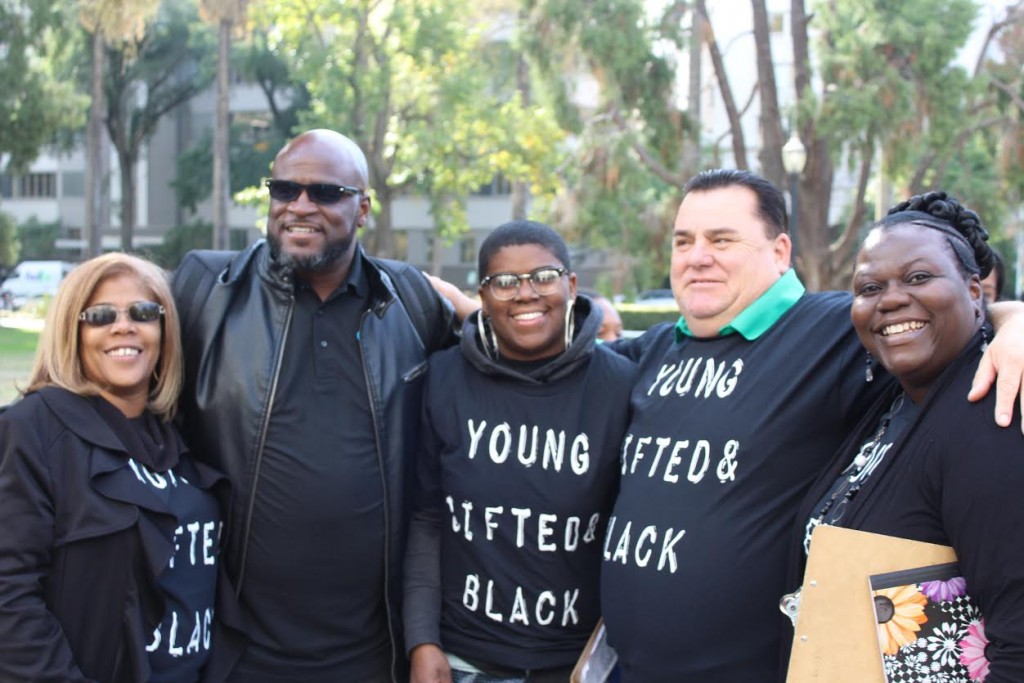
C.O.P.E. Staff- Sonya Hunn-Gray, Pastor Sam Casey, Devona Robertson, Sam (bus driver), and Felicia Jones
Cherq’uora Hunn, 10th grade student from Cajon High School, said she learned “that we can make a huge impact if we try.” Her favorite part of the trip was chanting in front of the Department of Education office building. Like Hunn, this was the first time many of the students had ever visited the state capital.
According to the Black Minds Matter research report, African American children often begin kindergarten already behind. Yet, instead of organizing the K-12 school system to ameliorate the problem the students also get less academically in school too. One notable fact is that California’s African American students, along with Latino students, often attend highly segregated schools. Where nearly 70 percent of their peers are African American and Latino, and just over 65 percent are poor.
Academically speaking, African American students not only have less rigorous core academic content, but they also have less access to a board and enriching curriculum. African American students are underrepresented in laborious courses such as Algebra 2, Advanced Math, Calculus, Chemistry, and Physics. In addition, less than one third of African American students complete the A-G courses required to be eligible for a UC or CSU. According to the California Department of Education, only 31% of 12th grade graduates African American students completed the A-G course sequence.
For some of the older students who are currently applying to college, the statistics regarding the state of African American success rates was upsetting but not discouraging. Dropout rates are far higher for African American students than for other students, and conversely, graduation rates are lower. This is not new information. “I feel that it (the rally) was very eye opening to the issues still present today,” said Lindsay Collins, 11th grade student at Redlands East Valley High School. She believes that it was a great experience and that more students need to be able to be engaged in and that she was empowered by the event. “I matter in all things I do.”
The experience was eye opening for the students, even the ones who did not expect to learn anything new. “I came in expecting to hear things I heard before, but I ended up coming away with new knowledge and possibly a new mindset,” stated Lyndon Nicholls, 12th grader at Cajon High School. “I learned, to achieve the best, that I can be anything I set my mind to and to ignore all negative voices.”
It is refreshing to hear the positive attitude of a African American student who’s next step in life is college, however; that is not what the numbers show as a majority. African American students are far more likely to attend community colleges that pubic four-year universities, partly because they are not properly prepare for the level of work needed to exceed in those school. Based on Education Trust-West analysis of California’s Academic Performances Index data from 2013, the institution types attended by California’s African American first –time freshmen are as follows: 67% California Community Colleges, 12% California State University, 11% Private For-Profit, 6% Private Nonprofit, and 4% University of California. For University of California, Irvine (UCI) student Sion Habtemariam, graduate of Citrus Valley High School and now in her junior year in college, not seeing other African American students on campus who are not athletes is a sad reality. “I know more African American could succeed in the UC system but the requirements are based on a students’ course load/level and the admission process is very competitive.” Just like UCI, African American students represent only 4%of the student body at University of California, Los Angeles (UCLA), a figure that has declined by 2 percentage points since affirmative action was banned at the University of California in 1995.
The Black Minds Matter report has “challenged district and state leaders to address the systematic inequities bearing down on you Black California’s. Both the report and the recommendations included in it are intended to be part of a larger effort that addresses educational disparities with the sense of fierce urgency our students deserve.” A concerted effort must be made by all that are involved, including educators, administrators, elected officials, policymakers, parent, and students to make equality a priority. Trimonisha Singer, mother, teacher, and active community, was pleased that her son Terriq Singer, 10th grade student at Cajon High School, was able to participate in this historic event. “I am thankful that C.O.P.E. gave my son the opportunity to experience history. Many negative stereotypes exist about this generation and in particular black youth. This not only showed that our youth do care about their future and letting their voice be heard but also gave the students a chance to experience their civil duties and what being a part of positive chance looks like.” It was a very important event that was made a positive impact on all the students in attendance. Singer also noted that her son “came home with the desire to be involved in his community and helping others realize that Black Minds Matter.”
 Westside Story Newspaper – Online The News of The Empire – Sharing the Quest for Excellence
Westside Story Newspaper – Online The News of The Empire – Sharing the Quest for Excellence
